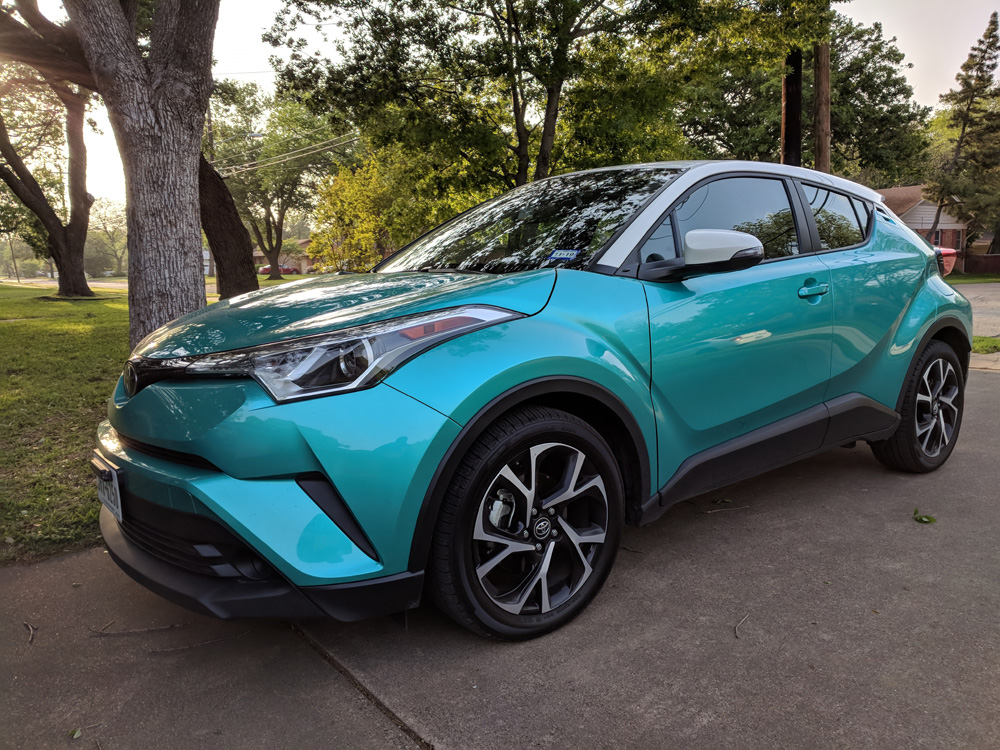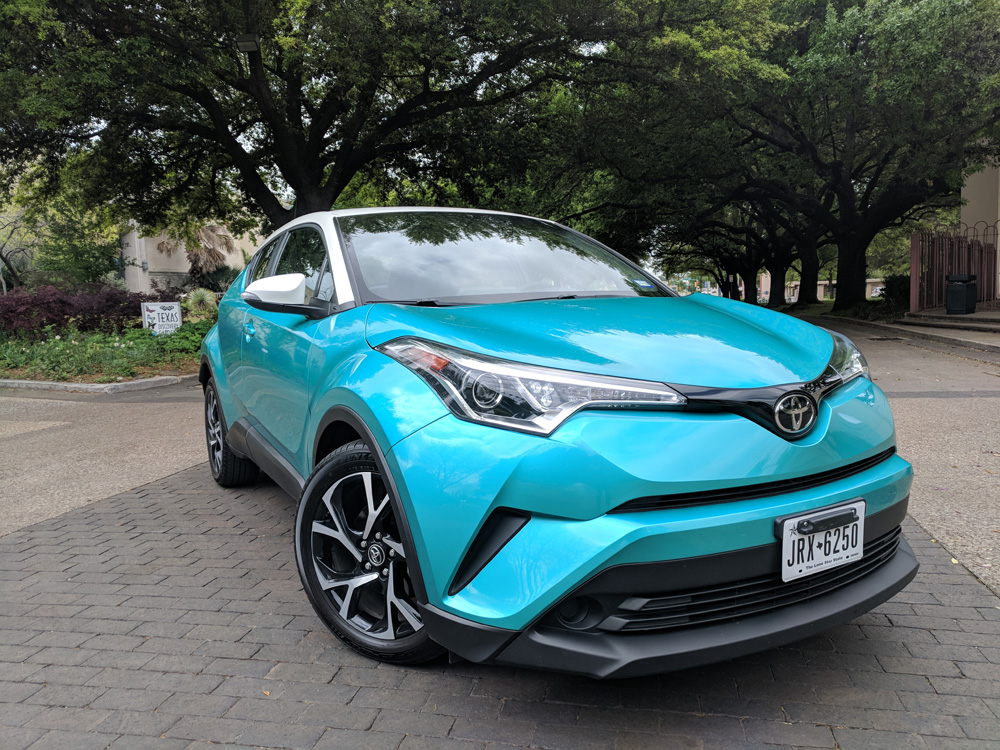Coupe, High Riding. That’s what C-HR stands for and its a moniker for a vehicle that’s not quite a sedan, not quite a hatchback and not quite a crossover. It is something in between, an explosion of shape, color
What I dig about the 2018 Toyota C-HR
What Kind of Car is That? – That’s the question that I was asked over and over again during the week I spent with the C-HR. Complete strangers would stop and inquire. It turned heads in traffic and more than once I was asked about it while going through a fast-food drive-thru lane. Everybody wanted to know what the heck I was driving.

The design of the C-HR can be polarizing but its all in the eye of the beholder and this beholder thinks it looks mighty fine indeed. Angular lines throughout the entire vehicle’s exterior, sharp swooping dips along the body line and a stylishly sloping roofline all culminate in what appears to be a stunted crossover. It’s length sure lands it the crossover class but its squatty appearance give it more of a hatchback vibe. Still, the C-HR is bulky and brawny, giving it a tough,

I particularly like how simple yet modern (and a bit robotic?) the nose is while the rear of the C-HR is more chunky and fun. It certainly isn’t all business in the front and fun in the back like a mullet but there is a certain aesthetic flow that can be followed from nose to trunk. Toyota offers the C-HR in seven different colors but only a handful of those colors can be paired with a contrasting white roof as part of an option Toyota calls “R-Code”. The turquoise color my test vehicle came in isn’t my favorite of the bunch but it sure caught the C-HR extra attention; there just aren’t many turquoise vehicles on the road so I was bound to get some glances. No joke, during one of those fast food drive-thru experiences I mentioned earlier one person at the window where I paid for my food turned up her nose at the turquoise color. When I rolled up to the next window, the person handing me my food said, “Oooo, I like that color!” Go figure.
Built Like A Hatchback with Interior Room Like A Crossover – Initially built for the Scion brand, Toyota has created a vehicle with a unique size that stands apart from the competition. Wide and tall, the C-HR at first glance looks like an oversized hatchback – and with the truck acting as a fifth door, it basically is a hatchback – but walk around the girth of the vehicle and it immediately feels more like a crossover. Which is exactly what Toyota was going for.

The C-HR is built on a mid-size platform but its rear axle sits deeper back like a crossover. This translates into a long vehicle that offers plenty of room for both driver and passengers. Generous leg-room and head-room are surprising, easily accommodating passengers 6ft and a little change. Seats actually allow all occupants to sit higher than a hatchback or sedan, hence the “High Riding” name. While the rear pillars created a bit of a blind spot, they are a part of a cargo area construction that allows for 19 cubic feet. With the rear seats down, this space expands to 36.4 cubic feet – a handsome amount of space that any driver could find use for.
The MeZone – While the zaniness of the exterior design is toned down inside the cabin of the C-HR, there is still plenty of innovative elements to admire. The infotainment center of the dash, for example, is thoughtfully designed and makes a whimsical statement in an otherwise minimalistic front console. The 7-inch touch screen juts out from the dash in a 90 degrees angle and is ever so slightly angled toward the driver. Climate controls and other various controls are nestled just below the screen, in a crooked “hanging basket” configuration that – again gives the interior some character. Toyota calls this little infotainment area the “MeZone.” If individualism is what Toyota was going for, the C-HR certainly has that in spades.

Attention to Interior Detail – If the devil is in the details then the interior of the C-HR is blazing hot. Small details abound through the cabin that were clearly designed with the angular design motif in mind. Toyota ingrains diamond shaped patterns through the doors and the dash that are subtle but bold. Combined with high quality material, these handsome touches are clear nods to the creative care that went into designing the C-HR.

Handling – A vehicle this eccentric appearing should be a joy to drive and it is…for the most part. Engine output is acceptable (more on that later) and the C-HR is nimble enough to traverse city traffic easily. Handling is exceptionally smooth, turning sharp curves to butter and creating a responsive driving experience that’s both spirited and
What Doesn’t Jive With Me About the 2018 Toyota C-HR
Subpar Engine Power – The C-HR may look like its ready to burn rubber but the 2.0-liter, four-cylinder engine under the hood produces more of a slow burn. Producing 144 horsepower and 139 lb-ft of torque, this engine produces adequate power to maintain speeds past a some-what sluggish acceleration but its unable to pounce from 0-60 mph in anything shorter than 10 secs. There is a Sport Driving Mode available to the driver at the turn of a knob but the adjustments don’t make a noticeable impact on speed or handling. On the other hand, the ECO Driving Mode definitely tames the engine down noticeably. The C-HR gets decent fuel economy – 27 mpg city, 31 mpg highway and 29 combined – and during my test drive, I found these estimates to be fairly accurate. However, vehicles this size currently on the market are garnering significantly better fuel economy than this, so it will be interesting to see how Toyota improves on this.
Where You Going C-HR? Off-Road? Turn Back Around! – The C-HR’s shape and configuration would have us think that it’s ready to rocket itself into the stratosphere. But in reality, it’s engineering is only really relegated to paved roads. There is no all-wheel-drive option for the C-HR which is puzzling when you consider that Toyota offers this option for the European and Japanese versions. Couple that with the slightly underwhelming engine and the C-HR is better left to city-streets. It’s a shame too because with it’s aggressive

Pricey – Toyota calls the C-HR a crossover vehicle and the sticker price reflections this designation. Starting at $23,499, the C-HR falls squarely in line with the cost of other crossovers on the market. But the C-HR isn’t quite a crossover and while it’s certainly roomy and feature-full, the price of admission reflects more of the brand name and

Lots of Potential
Perhaps the most intriguing aspect of Toyota’s C-HR is where it goes from here. Kudos to Toyota for introducing a niche vehicle to a crossover market that is not only becoming crowded but stagnant. The C-HR is an incrediabley unique option with very admirable options and value, even if this vehicle isn’t for every driver. I, for one, am excted what the future holds for the C-HR; for instance, how would a hybrid version drive or can a performance edition benefit (and sell) with a more aggressive engine configuration. Time will tell. Until then, the C-HR is an admirable introduction to what very well could be the future of thatchbacks crossovers.




